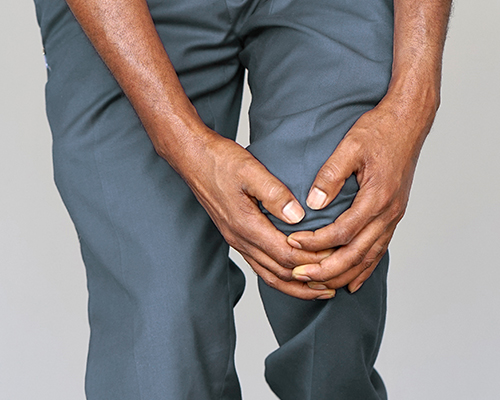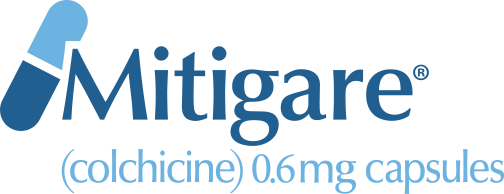
Although nine out of 10 people who suffer with gout agree that it is a serious health issue, far fewer are taking steps to manage it.1 In fact, just 10 percent of people with gout are getting the ongoing treatment they need.2 If you have gout, it is important to keep in mind that the condition is associated with other serious health issues such as kidney stones, diabetes and heart problems.3 Gaining control of gout and effectively managing it is critical.3 If you suffer with the disease, you may be asking yourself, “How can I tell if I’m managing my gout effectively?” and perhaps even more important, “How can I tell if my gout is getting worse?” Read on to find out.
Uric acid and gout
Gout is the most common form of inflammatory arthritis in adults.1 It is caused by high levels of uric acid in the bloodstream, a condition known as hyperuricemia.4 Hyperuricemia can develop when the body produces too much uric acid or has trouble eliminating it.4 The excess uric acid can cause urate crystals to form in and around the joints.4 Sometimes, these urate crystals can trigger the intense pain, swelling and redness you may recognize as a gout flare.5
Frequent, longer-lasting gout flares
After their initial gout attack, most people will have another painful flare within one year.2 Although it may be difficult for most gout sufferers to imagine anything more painful than that first gout flare, subsequent attacks often are more intense and last even longer.2,5 For some people, the pain of a gout flare is so intense they go to the emergency room seeking relief.2
Gout flares in multiple joints
The first gout attack typically happens in the first joint of the big toe.2 However, flares can occur in other joints as well—the feet, ankles, wrists, hands and elbows.2 Gout typically affects only one joint at a time, but when the condition becomes chronic it can affect multiple joints.6
Tophi
When uric acid levels in the bloodstream remain abnormally high for a long time, urate crystals can begin to form under the skin around the joints.5 These lumpy, chalky, white or yellowish-white nodules are called tophi.7 The higher your uric acid level is and the longer you’ve had gout symptoms, the more likely you are to have tophi.7 These unsightly growths can make it difficult to function normally, especially if they develop in your hands and feet.7 Tophi are usually found around the fingers, at the tips of the elbows and in the feet, but they can appear anywhere in the body.7 Tophi typically are not painful, but can become swollen and tender during gout attacks.5
Limited mobility
When gout becomes more severe, range of motion can become limited.5 Urate crystal buildup in the joints can make them feel uncomfortably stiff and swollen, and tophi can interfere with necessary movements such as walking and/or performing basic self-care tasks (like holding a toothbrush).8,9 For some people, the mobility limitations resulting from tophi affect normal functioning and can even threaten their independence.7
Emotional impact
Uncontrolled gout can take a toll on not just the body, but also one’s emotional well being.7 According to a qualitative research study published in 2014, the effects of gout on peoples’ lives can go above and beyond pain and functional limitations.10 According to the study, gout can impact almost every aspect of life—sleep, social interactions, sexual function, emotional health and more.10 If gout begins to affect your mental health, tell your doctor right away. He or she may be able to help you more effectively manage your symptoms and cope with the emotional aspects of the disease.
Your doctor may be able to help
If you have gout and suspect it might be getting worse, contact your doctor. He or she will most likely want check your uric acid level and possibly conduct some other tests.11 Based on the results, your doctor may suggest urate-lowering therapy (ULT).12 If you are already taking this kind of medication, he or she may find it necessary to adjust your dose.12 Your doctor may also recommend a medication such as Mitigare® (Colchicine) 0.6mg Capsules or Generic Colchicine Capsules to help prevent gout flares.12,13
Mitigare® is a registered trademark of Hikma Pharmaceuticals USA Inc.
Colchicine 0.6mg capsules are contraindicated in patients with renal or hepatic impairment who are currently prescribed drugs that inhibit both P-gp and CYP3A4. Combining these dual inhibitors with colchicine in patients with renal or hepatic impairment has resulted in life-threatening or fatal colchicine toxicity. Patients with both renal and hepatic impairment should not be given Mitigare®.
Fatal overdoses have been reported with colchicine in adults and children. Keep Mitigare® out of the reach of children.
Blood dyscrasias such as myelosuppression, leukopenia, granulocytopenia, thrombocytopenia and aplastic anemia have been reported with colchicine used in therapeutic doses.
Monitor for toxicity and, if present, consider temporary interruption or discontinuation of colchicine.
Drug interaction with dual P-gp and CYP3A4 inhibitors: Co-administration of colchicine with dual P-gp and CYP3A4 inhibitors has resulted in life-threatening interactions and death.
Neuromuscular toxicity and rhabdomyolysis may occur with chronic treatment with colchicine in therapeutic doses, especially in combination with other drugs known to cause this effect. Patients with impaired renal function and elderly patients (including those with normal renal and hepatic function) are at increased risk. Consider temporary interruption or discontinuation of Mitigare®.
The most commonly reported adverse reactions with colchicine are gastrointestinal symptoms, including diarrhea, nausea, vomiting and abdominal pain.
Please see the full Prescribing Information and Medication Guide for Mitigare® for complete product details.
NOTE: This article was not written by a medical professional and is not intended to substitute for the guidance of a physician. These are not Hikma’s recommendations for gout flare prevention, but rather facts and data collected from various reliable medical sources and guidelines. For a full list of resources and their attributing links, see below.
